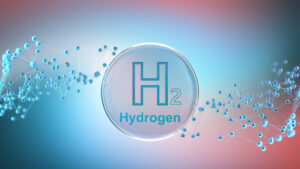HyTerra backs white hydrogen to pick the low-hanging decarbonisation fruits

Hydrogen can quickly decarbonise ammonia and fertilisers. Pic: Getty Images
- White hydrogen has amongst the lowest cost and carbon intensity of all hydrogen sources
- It can deliver immediate decarbonisation goals by supplying existing sectors such as fertilisers, plastics, cement and steel
- The “low-hanging fruit” is ammonia and fertilisers
- HyTerra is poised to start drilling in Q3 2024 at its Nemaha Ridge hydrogen and helium project in Kansas
The road to net zero emissions requires a multi-pronged approach – using renewables, hydrogen, and increased efficiency – to make a near-term impact as you can’t electrify everything.
In order to achieve this, we might be best served addressing the low-hanging fruit, that is to say industries and sectors that can be quickly decarbonised by swapping out say a feedstock manufactured using a process with high carbon intensity with the same feedstock made using a low or zero carbon process.
The use of hydrogen is one such area that presents great potential for decarbonising the low-hanging fruit.
While many people aren’t familiar with hydrogen as it is not a traded commodity like gold and silver, it is nonetheless interwoven into our daily lives in many ways.
Notable examples of sectors and products that use hydrogen include fertilisers and refining, with the first being the very definition of a low-hanging fruit with the potential for massive impacts.
That these are often the same industries that can’t be electrified easily just adds to the process of decarbonising them.
Ammonia fertiliser for one requires significant amounts of hydrogen, which at this point comes largely from fossil fuels.
Replacing this fossil fuel-derived hydrogen with hydrogen produced using cleaner methods will make an immediate difference to our emissions, particularly since fertiliser production is only projected to keep growing as the world’s population grows.
While most people in the know will point towards the use of green hydrogen – ie using electrolysers powered by renewable energy to crack water into oxygen and hydrogen – as being the obvious choice to do so, HyTerra (ASX:HYT) executive director Benjamin Mee believes the answer can be found under our feet.
The case for white hydrogen
While he doesn’t necessarily disagree that green hydrogen can clean up ammonia (or other industries that use hydrogen), Mee thinks that white hydrogen (also known as gold or natural hydrogen) found in reservoirs similar to those that host oil and gas represents a low-cost option that also wins the emissions sweepstakes.
“White hydrogen is basically hydrogen made naturally by the earth and as a result there is an immediate advantage from a cost and carbon perspective that could be central to the future of the hydrogen industry,” he told Stockhead.
“At the front end you have very low cost, maybe the lowest cost, potential in the hydrogen business.
“Second, it has a very low carbon intensity because you didn’t spend all that effort to mine materials needed to manufacture solar panels, wind turbines, electrolysers and all the bits and pieces needed to produce green hydrogen.
“So, white hydrogen should be able to compete against grey hydrogen, which is fossil fuels based, in terms of cost and would beat them hands down in terms of carbon. Competes against green hydrogen by at very least matching carbon emissions but at a lot lower cost.”
The low expected cost of producing white hydrogen is a significant point with Mee noting that the lowest cost producer always wins in the short term.
In the long-term, he expects customers to factor in life cycle carbon emissions when considering the different methods of hydrogen production.
Mee pointed out that the oil and gas industry is very good at calculating carbon emissions and this rigour will be applied to all forms of hydrogen.
“Today we look at colours like white, grey, yellow, blue, green etc. These colours help us identify how hydrogen is made,” he said.
“In the near future, I believe the discussion will shift more to what is the life cycle intensity of what we trying to achieve.”
“That’s where the attributes of white hydrogen will support the cause.”
And while it is an emerging source of energy, white hydrogen also benefits from being able to apply existing skillsets and technologies from mining, oil and gas, and managing water to the extraction of hydrogen.
Mee pointed out that drilling for hydrogen, which is essentially a brand new energy source that no one really understands yet, has similarities to drilling for geothermal energy. Both use methods from the optimised oil and gas industry.
Challenges ahead
It is not all sunshine and rainbows though.
As one would expect from trying to develop a new energy source, there are challenges involved in bringing white hydrogen to the market.
Mee notes that the first is there is no one recipe for finding and extracting hydrogen.
“Companies are actually developing that recipe now because it is so new,” he said.
Further complicating this challenge is that companies can be expected to keep that recipe, which is essentially their intellectual property, pretty close to their chests. This means that there would not be much data sharing between companies in the coming years.
“The second challenge is explaining it, the education of what it can be to the market and helping to create that demand and resilience to any hydrogen economy that pops up around the world,” Mee added.
“Third is the legislation that still needs to be in place. That’s evolving as we see now in Western Australia, as an example.”
He noted that some countries – such as the US where HyTerra is operating – are already well advanced in this area, noting that it was a great jurisdiction with all the incentivised regulation ready to.
Nemaha Ridge poised to go
HyTerra is a global early mover. Central to HYT’s efforts to prove its own recipe to be a frontrunner in the white hydrogen space is its 100%-owned Nemaha Ridge project in Kansas, which sits between Kansas City and Wichita in the centre of a major industrial and manufacturing hub.
The project currently has 12,720 acres of exploration leases with good proximity to existing railways, roads, and pipelines that connect it to a long list of potential offtakers nearby including ethanol and ammonia manufacturers, and petrochemical plants.
There’s also significant evidence that hydrogen is indeed present with the company’s acreage hosting historical wells with hydrogen and helium occurrences in the region, some returning up to 92% hydrogen and 3% helium.

Mee said the company had went in and looked at the wells along with the thousands of wells across the US.
“We liked the jurisdiction, proximity to industry, and we liked the rocks,” he noted.
“We then came up with the geological model that could explain why those occurrences are there and we leased those occurrences.”
Taken together, Nemaha Ridge has all the basics required for project resilience.
“You want to have proximity to customer, you want to have low-cost extraction and you want to have good rocks and good play diversity,” Mee said.
“You have got to have a lot of things to try. More shots on goal from the start.”
HYT has already tagged Nemaha Ridge with a best estimate prospective resource of 100.2 billion cubic feet of hydrogen and 0.47Bcf of helium and plans to continue leasing more acreage to build its position.
It recently raised $6.1m through a placement and fully underwritten rights issue, placing it in the position to drill in Q3 2024.
Mee notes that Kansas has rigs available and has an existing services industry, ensuring that oil and gas service providers can be hired as required.
“The trick now is to go find the hydrogen and understand it, drill it out, and replicate that globally and we are looking at different opportunities around the world,” he added.
HYT will first drill some exploration wells, decide on appraisal wells and flow testing before making a decision on commerciality and building a pilot plant to demonstrate early commerciality.
“While we do that, we still need to explore, keep building and leasing to build scale in our priorty areas,” Mee added.
“To do that, we have to start derisking and handling subsurface uncertainty and that’s what we are good at. You can only do that through geophysical surveys, geological surveys, and drilling.”
He added that while there are plenty of potential hydrogen opportunities in the US, the company was also looking globally as there are different geological models to unlock.
“It is going to be quite interesting to see what we do next.”
Related Topics

UNLOCK INSIGHTS
Discover the untold stories of emerging ASX stocks.
Daily news and expert analysis, it's free to subscribe.
By proceeding, you confirm you understand that we handle personal information in accordance with our Privacy Policy.








